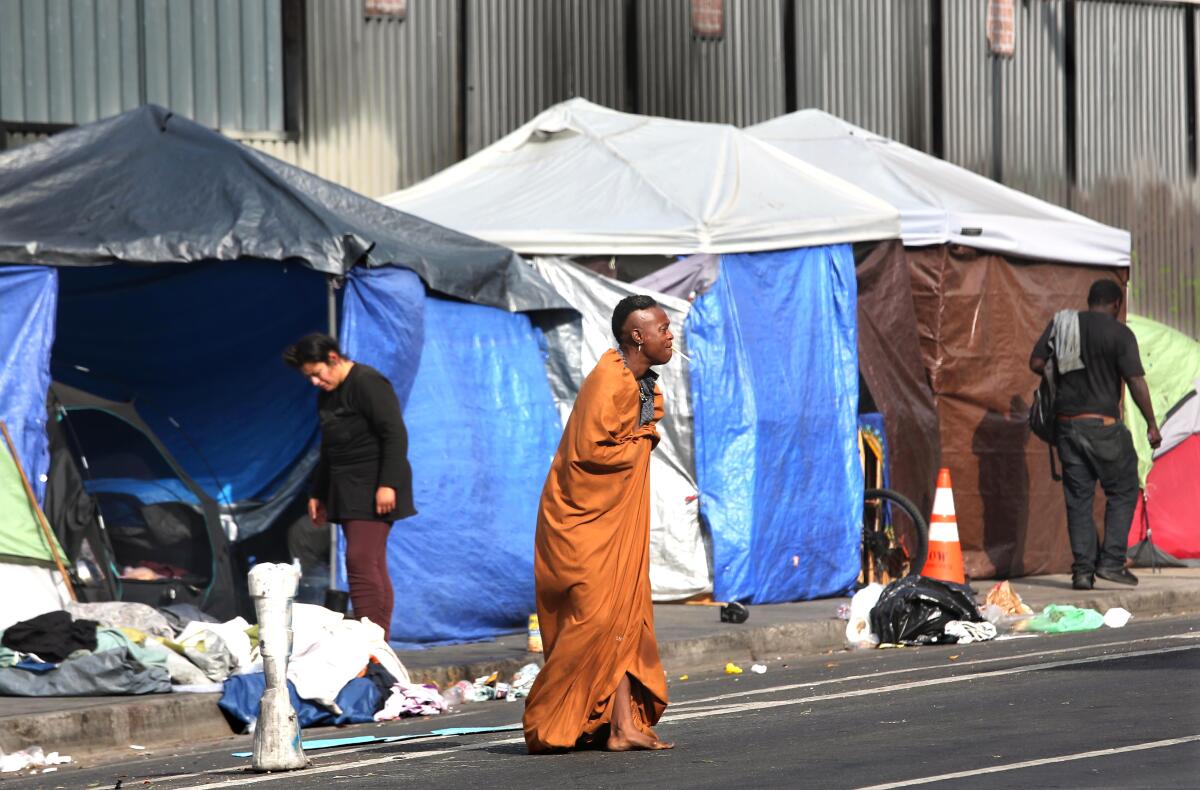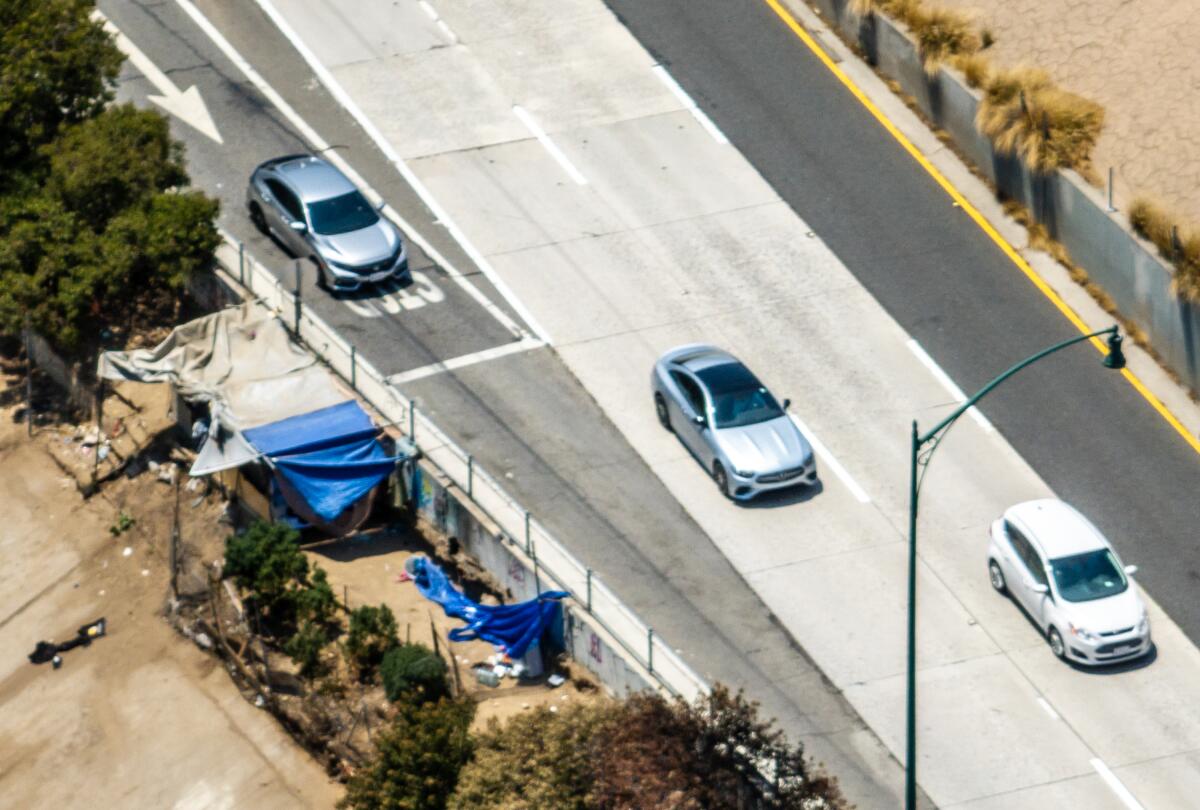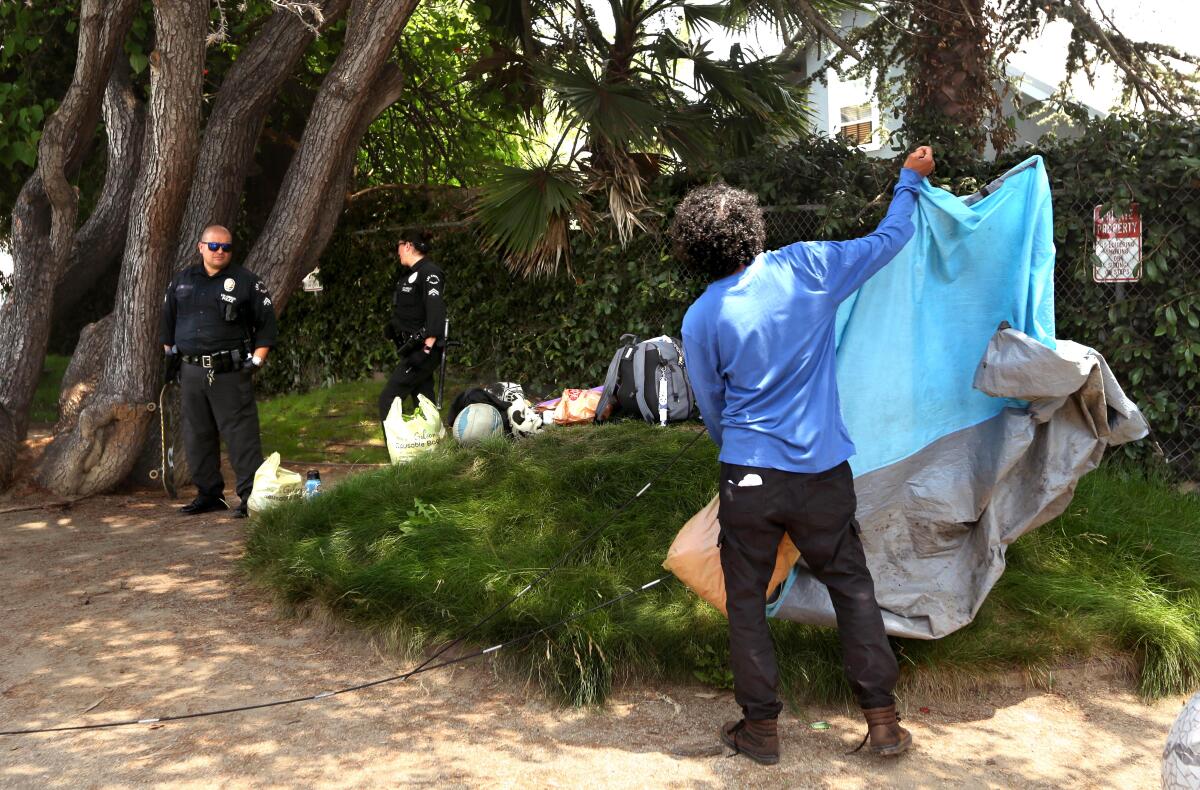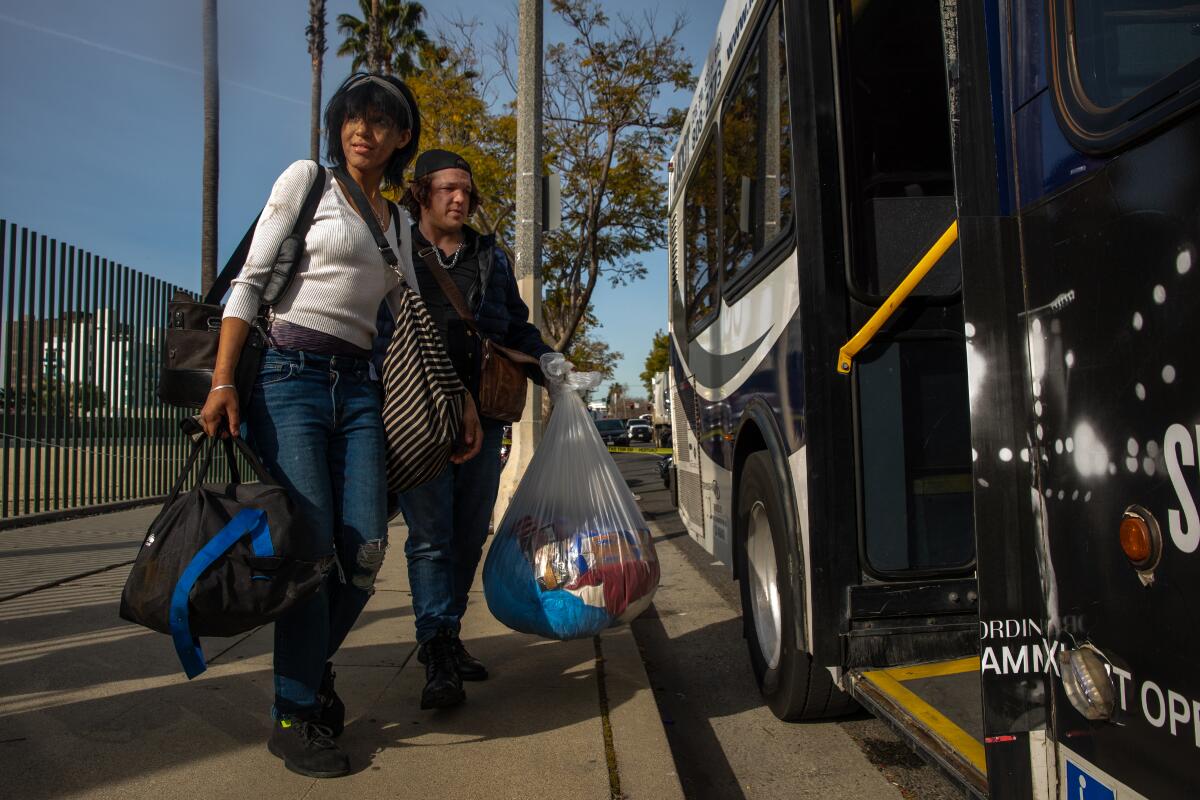Newsom orders California agencies to clear homeless camps, but the impact remains a question

- Share via
Gov. Gavin Newsom issued an executive order Thursday requiring state agencies to remove homeless encampments in their jurisdictions and urging cities to follow suit, a gesture that raised alarm among homeless advocates but drew a muted reaction from Los Angeles officials who say they are already doing so.
Citing the U.S. Supreme Court’s June ruling that lessened restrictions on the enforcement of anti-camping laws, the order said there is “no longer any barrier to local governments utilizing the substantial resources provided by the State, in tandem with federal and local resources, to address encampments with both urgency and humanity, or excuse for not doing so.”
Los Angeles County Supervisor Lindsay Horvath, who had blasted the Supreme Court ruling as “unconscionable,” said she did not see Newsom’s order as requiring anything the county isn’t already doing with its encampment removal program.
“Los Angeles County’s Pathway Home Program is doing exactly what this state order calls for — urgent and humane encampment resolution,” Horvath said. “Los Angeles County is — and has been —all in on doing our part under our homelessness emergency.”
Shayla Myers, a Legal Aid Foundation of Los Angeles attorney who has sued L.A. repeatedly over its treatment of its homeless population, suggested Newsom was grandstanding.
“Blaming court injunctions that protect our most vulnerable residents is political rhetoric at its worst,” Myers said.
Newsom characterized the proliferation of encampments as a health and safety hazard that requires immediate action.
“We must act with urgency to address dangerous encampments, which subject unsheltered individuals living in them to extreme weather, fires, predatory and criminal activity, and widespread substance use, harming their health, safety and well-being, and which also threaten the safety and viability of nearby businesses and neighborhoods, and undermine the cleanliness and usability of parks, water supplies and other public resources.”

The prevalence of homelessness in California is a problem that could pose a threat to Newsom’s ambitions for higher office. Newsom, who is widely seen as a future candidate for president, would undoubtedly face attacks over the large number of people who sleep in tents and doorways all over the state.
Democratic political consultant Andrew Acosta said the executive order is “vague” and lacks substance but allows Newsom to avoid accountability for one of his biggest political problems.
“I think part of this is trying to move this discussion away from Newsom and push it down to other folks to say: you need to do more,” he said. “You’re hard pressed to find anybody who is praising this order. I don’t think it’s really going to change what people see on the streets every day.”
Republicans called it a publicity stunt and criticized Newsom for not going far enough on enforcement.
“While I am cautiously optimistic that the governor has finally taken note of the urgency of this problem, albeit many years later than needed, Californians deserve government for the people, not the PR hits,” Senate Minority Leader Brian W. Jones (R-Santee) said in a statement Thursday.
Despite its tone of urgency, the order sets no specific timeline for agencies to remove encampments. Nor does it lay out a program for providing the tens of thousands of new shelter beds and permanent housing that would be needed to accommodate the state’s estimated 181,000 homeless people, 70% of whom are unsheltered.
In a 6-3 decision, the justices upheld the ability of the city of Grants Pass, Ore., to enforce a law that prohibited camping in public places even though the city had no shelter to offer people being forced to leave. The ruling overturned the 9th Circuit Court in San Francisco and ruled that it is not “cruel and unusual” punishment for city officials to forbid homeless people from sleeping on the streets or in parks.
Newsom’s order requires state agencies to adopt policies modeled after a California Department of Transportation directive that “prioritizes removal of encampments that pose threats to life, health and safety, while partnering with local governments and nonprofit providers to facilitate offers of shelter and supportive services in advance of removal.”
Encampments judged to pose “imminent threat to life, health, safety or infrastructure” must be addressed immediately, though the directive does not provide a specific deadline.
Caltrans has cleared 11,000 homeless encampments since 2021 as the agency devotes an increasing amount of its resources to taking down tarp tents and makeshift kitchens alongside and under freeways.
The condition of homeless individuals living near the massive concrete structures, which both cool and protect them from the rain and heat, has become both a health issue and a serious safety concern for Caltrans.
Up and down the state, fires have threatened to compromise hulking concrete freeway structures and put lives in danger. A pregnant woman living under the 10 Freeway was among more than dozen homeless people who reportedly escaped a massive fire that broke out last November and shut down the freeway for a week.
The Caltrans policy has “mechanisms for providing the people within the encampments care and dignity and the services that they need,” said Newsom’s spokeswoman, Tara Gallegos.
The order expands those efforts to other state-owned properties such as state parks.
Under Caltrans’ maintenance order, the agency identifies encampments and labels them based on their risk to structures and life, with those of highest risk given priority. When camps are cleared, Caltrans gives its residents 48 hours to leave and should connect them with housing assistance. The agency also holds their items for 60 days.
Though the governor cannot force cities and other jurisdictions to follow the order, he encouraged them to use “substantial funding provided by the state to take similar action.”
Overall, the governor has dedicated $24 billion to clean up encampments, move Californians off the streets and sidewalks and convert hotels and motels into temporary shelters, among dozens of other initiatives.

Newsom has taken a moderate approach to homelessness as governor, departing from his image as a liberal California leader on an issue that has become a top priority of his administration.
The governor has spent more money on the issue than his predecessors and taken a hard-line stance on encampments, actions that have resulted in criticism from progressives and conservatives.
The governor celebrated the Grants Pass decision, aligning himself with the conservative U.S. Supreme Court, saying it removed legal ambiguities that “tied the hands of local officials for years.”
Growing increasingly frustrated over the lack of progress, he threatened in April to withhold homelessness funds from cities and counties that do not follow through, saying “I’m not interested in funding failure any longer. I want to see results.”
Mayor Karen Bass, who was in Paris for the Olympic Games, issued a statement saying that strategies that move people from one neighborhood to the next — or rely on citations and financial penalties — do not work.
Bass has focused much of her energy on her Inside Safe initiative, which has been moving homeless people out of encampments and into hotels, motels and other forms of temporary housing.
“We thank the Governor for his partnership thus far and hope that he will continue collaboration on strategies that work,” the statement said.
Inside Safe has brought nearly 2,900 people indoors since December 2022. (About 900 have left that housing, with the vast majority returning to homelessness, according to the Los Angeles Homeless Services Authority.)
Bass has pointed to the most recent count, which found that homelessness declined by 2.2% in the city compared to the previous year, a figure that is within the margin of error. The number of homeless people who are living on the street dropped by more than 10%.

County Supervisor Kathryn Barger applauded Newsom’s decision to issue the order, saying it places an “emphasis on urgency.” The order reinforces the idea that local government agencies are the ones who are “at the helm of homeless encampment removals,” she said.
Redondo Beach City Atty. Mike Webb said it’s not possible to “arrest your way out” of homelessness, but in the wake of the Grants Pass ruling, the city is looking at ways it can give authorities more tools to get people off the streets and enforce anti-camping rules. He said he briefly reviewed Newsom’s order and that it appears nothing is binding on cities. “It won’t really change or speed up what Redondo Beach is doing,” Webb said.
But some homeless advocates interpreted the order as cover for cities to start cracking down on homeless people.
“The Grants Pass ruling doesn’t change the state’s ability to address actual public safety threats, but it also doesn’t give the state or cities free rein to clear encampments and criminalize homelessness,” Myers said. “Shifting the state’s priorities to erasing the evidence of homelessness instead of housing people is going to make this crisis worse, not better, and it will lead to more litigation and court injunctions.”
Garrett Miller, president of the Los Angeles County Public Defenders Union, panned the order, saying Newsom should focus on providing more housing for the state’s homeless population, not “violent encampment sweeps that push people from one corner to another.”
“There are enough resources in California that no one should be living on the street,” Miller said in a statement. “He can start by establishing a right to housing. Until that is realized, this executive order is completely unconscionable.”
Katie Tell, chief external affairs officer for the homeless services and housing nonprofit PATH, said in a statement that “PATH is deeply concerned by the lack of actual dedicated funding attached to this Executive Order to do the much-needed work of resolving unsafe encampments in an effective, trauma-informed, and permanent way.”
“Local governments are not lacking in urgency — they are lacking in consistency, social workers, shelter beds, and affordable housing.”
Staff writers Andrew Khouri and Mackenzie Mays contributed to this report.
More to Read
Sign up for Essential California
The most important California stories and recommendations in your inbox every morning.
You may occasionally receive promotional content from the Los Angeles Times.














